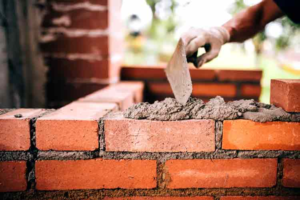Brick Masons Charleston SC build and repair walls, floors, partitions, fireplaces, chimneys, and other structures using solid brick, concrete blocks, or prefabricated masonry panels. They also transport materials and equipment to construction sites.
Masons must be familiar with the requirements of each type of masonry work and its applications. They must also understand the proper mixing proportions for mortar types and the appropriate tools and equipment.

Brick masons need to possess physical stamina and strength to handle heavy materials and endure long periods of labor. They need to have good hand-eye coordination and dexterity to manipulate tools effectively and accurately. They must be proficient in mathematical skills to measure and calculate dimensions and quantities of materials needed for construction projects. Brick masons also need to have strong problem-solving skills to overcome construction challenges and troubleshoot any issues that arise during the course of a project.
As a skilled tradesman, brick masons need to possess excellent interpersonal skills to collaborate with their coworkers and supervisors on construction projects. They must be able to communicate clearly and concisely in order to prevent any misunderstandings or delays on the job site. Furthermore, brick masons must have great attention to detail in order to interpret blueprints and construction plans accurately. This helps ensure that the final structure matches the intended design both aesthetically and functionally.
In addition to these soft and technical skills, brick masons need to have strong work ethic and dependability in order to be successful in this profession. Many brick masons have the opportunity to advance in their careers and take on supervisory roles, enabling them to earn even higher wages.
Apprenticeships for brickmasons, block masons, and stone masons are available through unionized joint apprenticeship and training committees and local contractors. These programs typically last three to four years and include on-the-job training as well as classroom instruction in subjects such as blueprint reading, mathematics, layout work, and sketching. In addition, some brick masons may choose to pursue certification through a national or state organization that certifies individuals in the field of masonry. This can enhance a career potential and help them to stand out from other candidates during the interview process.
Hand-Eye Coordination
Masonry is a physically demanding job that requires excellent physical stamina. Brick masons also need to be able to lift heavy materials and work in outdoor environments. These physical requirements, combined with a strong understanding of construction techniques and materials, are essential for becoming a successful brick mason.
Hand-eye coordination is necessary for brick masons to be able to apply mortar evenly and accurately. This skill ensures that the brick structures built by masons are aesthetically pleasing and structurally sound. Masons must also be able to manipulate tools such as trowels and brick hammers with precision, which again improves the quality of the finished product.
Adaptability is another crucial trait for masons to have, as construction projects often encounter unexpected challenges. Masons must be able to quickly assess and solve problems, such as structural issues or material shortages, in order to keep the project on schedule and within budget.
A keen understanding of the properties of various building materials is also important for masons, as it allows them to choose the best materials for their projects. Masons should have a good knowledge of how different types of bricks and stones react under certain conditions, such as weather changes or soil moisture levels.
In addition to building new brick structures, brick masons may be responsible for repairing or maintaining existing buildings or other structures. This work involves a combination of traditional masonry techniques with more modern repair methods, and it requires a keen attention to detail as well as an extensive knowledge of both old and new construction methods.
As brick masons gain experience and build up their skill level, they may be able to take on supervisory roles in the construction industry, which can significantly increase their earning potential. In some cases, masons can even start their own masonry businesses, which can provide them with greater independence and flexibility. However, the exact earnings of brick masons will depend on a variety of factors, including location and the specific sector of the construction industry. Nevertheless, brick masons are highly sought after professionals who are well-compensated for their expertise.
Attention to Detail
Attention to detail is a skill that can be learned and developed. Employers value employees with strong attention to detail because it can help them meet deadlines and produce quality work. This trait can also be beneficial in roles where errors can be costly to an organisation. For example, a finance administrator who accidentally lists a wrong amount on an invoice can cause financial losses and may even lead to legal challenges.
Masons must pay close attention to the details of each brick they use, as minor differences can affect the overall look and strength of a wall. This includes ensuring that the bricks are the correct color, size and texture to match the design of the project. Masons also need to pay close attention to the mortar used to bind the bricks together. Using the right consistency of mortar is essential to a brick wall’s structural integrity. Lastly, masons must carefully select and lay bricks in specific patterns depending on the structural requirements of the project.
Employees who have strong attention to detail are able to detect and resolve errors early on, which can help save time and resources that would otherwise be spent fixing them. Additionally, workers with attention to detail can ensure that their work meets or exceeds quality standards, which enhances reputation and improves customer satisfaction.
Demonstrating attention to detail in a job interview can impress hiring managers and boost your career prospects. To showcase this skill, share examples of how you’ve used it to complete a task, such as reviewing a document or organising data. You can also highlight relevant certifications or training that demonstrate your ability to pay close attention to detail.
However, being overly focused on the minutiae of a task can distract you from the bigger picture and may be perceived as nitpicky or controlling. To avoid this, try to keep your attention centered on the most important aspects of the work at hand. It’s also helpful to take frequent breaks and clear your workspace of distractions to allow your mind to relax. For example, you might consider removing distractions like music, TV or social media from your work environment to give your attention to detail the best chance of improving.
Communication Skills
Brick Masons need excellent communication skills to effectively work with other construction team members and ensure all deadlines and specifications are met. This is especially important if masons are working on projects that require a permit, as adherence to local ordinances can prevent project delays and costly fines. Clear communication also reduces the likelihood of misunderstandings and mistakes that can negatively impact the quality of finished structures.
Brick masons also use their communication skills when interacting with clients to ensure they receive accurate information regarding a job’s scope and requirements. For example, masons may need to explain how different types of masonry can impact the structural integrity of a building or structure. This is especially important if the project requires load-bearing walls or other special considerations.
Masons are also responsible for laying and binding building materials, such as bricks, blocks, concrete block, stone, terra-cotta block, glass block, or mortarless segmental concrete masonry wall units, with mortar to construct or repair walls, partitions, sewers, arches, foundations, retaining walls, and other structures. They must be able to identify the best materials for each project and understand how to properly lay them in order to ensure proper construction.
Due to the nature of their work, masons must be able to follow strict safety protocols when operating equipment and working with heavy materials. This includes adhering to all workplace safety regulations, ensuring that all tools are used correctly and thoroughly cleaning the work area to prevent accidents or injuries.
A career as a brick mason is both rewarding and challenging. Masons need to be physically fit and have excellent hand-eye coordination, but they must also be able to read blueprints and other construction plans and have strong problem-solving skills. For those interested in pursuing this profession, it is recommended that they enroll in a masonry apprenticeship program or join a union. Both of these options provide invaluable experience and networking opportunities that can help masons find employment in their chosen field.
Masons are essential to the construction industry, transforming architectural designs into tangible structures that can stand the test of time. Despite the challenges, this is an incredibly rewarding career that can be a great source of satisfaction for those who choose to pursue it.








